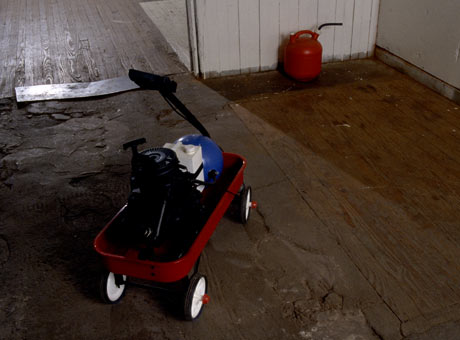Gregory Barsamian, Robert Chambers, Aaron Davidson, Melissa Dubbin, Hermann Feldhaus, Bruce Fowler, Robin Hill, Perry Hoberman, Sheila Moss, Jonathan Podwil, Kate Yourke, and Mary Ziegler
Simple mechanics, obsolete technology and outdated science is adopted by artists who have in common a desire to investigate methods once used by industry, but now on the endangered species list. Popular Mechanics includes artists who use drawing, film, cyanotypes, video, animation, zoetropes, hair dryer blowers, motors, scanners, sensors, braille, bar codes and paint in an exploration of art, science and illusion.
Gregory Barsamian presents No Never Alone, a three dimensional animated sequence on a spinning armature supported by a synchronized strobe light for illumination. It is a three dimensional zoetrope, a series of sculptures, which when spinning look as if they are one moving image. An animation without the film. In another sort of animation, Kate Yourke creates an illusion of moths hovering and fluttering around a miniature landscape embedded in familiar (and grody) objects; a bucket, mop, sponge and rag. In this instance the illusion is created simply by projecting an image of the moth onto spinning strings. Robin Hill creates a large site specific photograph and installation using the unusual architecture of Smack Mellon’s 19th century. Cyanotype is a 19th century photographic process and was the precursor to the modern-day blueprint. Unlike the blueprint, the cyanotype is archivally sound. A two part chemical formula sensitizes the coated paper to ultraviolet light which allows for very simple exposures to take place in a studio setting. In her cyanotypes matter is translated into degrees of opacity and translucency which are the two dimensional counterparts to thick and thin. The cyanotypes document the gesture of placing physical matter on paper.
Hermann Feldhaus presents three individual viewer-operated projectors linking three discreet short films loops into one larger panoramic projection. Hermann takes his cue from J.-E. Marey’s research. Whereas Marey broke down the movement of the animate into the discreet phases of a series of photographs in order to study its movements, Feldhaus’ work does the reverse by combining the discreet phases of an imagined movement of the inanimate into a crude animation. Sheila Moss presents Hugo de Vries and the Amorphophallus titanium, a spinning lantern with the image of the famous botanist standing next to the world’s second largest flower. The image shimmers, folds and mutates on itself as it is projected onto the wall. Sheila also shows a life size drawing of the flower.
Robert Chambers, the master of absurdity, transforms the idea of a dignified grandfather clock into a clanking and clumsy machine, beautiful in it’s honest uselessness. Mary Ziegler’s Standing changes what looks like a study of fluid dynamics into a reflection on the act of effort. 2 seven foot long sheets of drycleaner plastic hang tethered between a series of sequenced blowers. The slow drifting, airborne choreography that results depicts the willfull successes and thwarted failures of a simple, repeated attempt to stand up from a sitting position. Melissa Dubbin and Aaron Davidson collaborate on two new works: Night Writing is a series of music boxes that broadcast the coordinates of the Smack Mellon gallery, via ‘sonified braille’encoded on the barrel of each music box. These motor-driven boxes are inspired by a technique developed during the Napoleonic era, a phonetic system of raised dots on paper allowing soldiers to communicate quickly, secretly and silently in the battlefield, ultimately spawning the invention of Braille. Their second work, Classifying Apparatus and Method – Memories of Malfunction is a mechanical musical instrument in the spirit of a hybridized bar code player piano. Bruce Fowler presents a child’s red wagon which carries a far too large lawn mower motor. Perry Hoberman’s Zombiac consists of computer terminals and monitors ranging in vintage from the 1970s to the present. The original electronics have been removed transforming them into mindless ‘electronic brains’. Sensors in the system allow them to respond to movement or sound in the room. As visitors enter, sensors track their movements, triggering monitors to turn to watch them and ‘communicate’ with patterns of light and sound. Jonathan Podwil builds and then films with super 8, models of a Vietnam war era helicopter and a WWII airplane. He then scans the film and digitally remakes it presenting the final version in video form. In this way he creates what appears to be found bits of documentary film. Podwil also makes paintings of the images on screen, creating a relationship between the moving and the motionless image.
